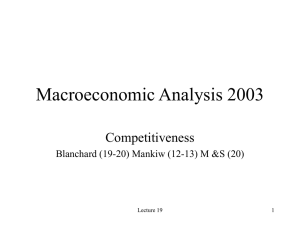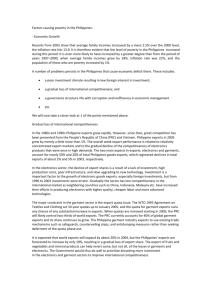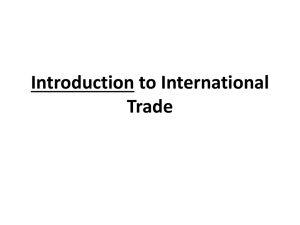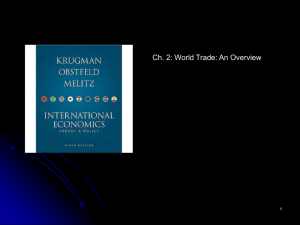7_anca dachin.pmd
advertisement
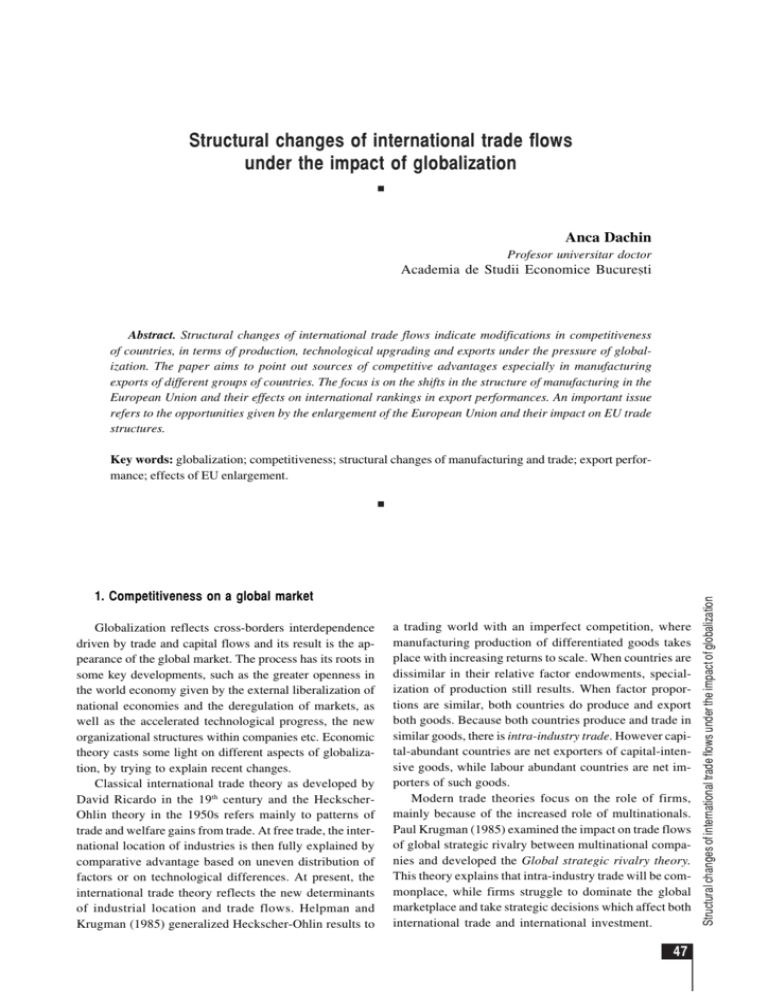
Structural changes of international trade flows under the impact of globalization n Anca Dachin Profesor universitar doctor Academia de Studii Economice Bucureºti Abstract. Structural changes of international trade flows indicate modifications in competitiveness of countries, in terms of production, technological upgrading and exports under the pressure of globalization. The paper aims to point out sources of competitive advantages especially in manufacturing exports of different groups of countries. The focus is on the shifts in the structure of manufacturing in the European Union and their effects on international rankings in export performances. An important issue refers to the opportunities given by the enlargement of the European Union and their impact on EU trade structures. Key words: globalization; competitiveness; structural changes of manufacturing and trade; export performance; effects of EU enlargement. 1. Competitiveness on a global market Globalization reflects cross-borders interdependence driven by trade and capital flows and its result is the appearance of the global market. The process has its roots in some key developments, such as the greater openness in the world economy given by the external liberalization of national economies and the deregulation of markets, as well as the accelerated technological progress, the new organizational structures within companies etc. Economic theory casts some light on different aspects of globalization, by trying to explain recent changes. Classical international trade theory as developed by David Ricardo in the 19th century and the HeckscherOhlin theory in the 1950s refers mainly to patterns of trade and welfare gains from trade. At free trade, the international location of industries is then fully explained by comparative advantage based on uneven distribution of factors or on technological differences. At present, the international trade theory reflects the new determinants of industrial location and trade flows. Helpman and Krugman (1985) generalized Heckscher-Ohlin results to a trading world with an imperfect competition, where manufacturing production of differentiated goods takes place with increasing returns to scale. When countries are dissimilar in their relative factor endowments, specialization of production still results. When factor proportions are similar, both countries do produce and export both goods. Because both countries produce and trade in similar goods, there is intra-industry trade. However capital-abundant countries are net exporters of capital-intensive goods, while labour abundant countries are net importers of such goods. Modern trade theories focus on the role of firms, mainly because of the increased role of multinationals. Paul Krugman (1985) examined the impact on trade flows of global strategic rivalry between multinational companies and developed the Global strategic rivalry theory. This theory explains that intra-industry trade will be commonplace, while firms struggle to dominate the global marketplace and take strategic decisions which affect both international trade and international investment. 47 Structural changes of international trade flows under the impact of globalization n Economie teoreticã ºi aplicatã In a series of papers (Blomström, 1993), authors have made the distinction between the competitiveness of countries, as geographical entities, and that of firms that may have headquarters in a country, but can produce in many countries. According to these authors, there are advantages in using exports rather than production for measuring competitiveness and comparative advantage. The main advantage for this purpose is that exports are somewhat more footloose. Shares in export markets may represent the underlying advantage of countries or firms to a greater degree compared to shares in domestic markets, because export markets are less affected by government interventions or other non-economic factors. They find that countries and multinationals headquartered in these countries have different comparative advantage. Despite globalization, authors have also discussed the importance of geographical proximity and local sources of competitiveness, by using terms such as economies of clustering, systemic competitiveness, local innovation systems and collective efficiency. Michael Porter (1991) argues that a nation’s competitiveness depends on the capacity of its industry to innovate and upgrade and emphasises the importance of clustering. Globalization of the world economy has been associated with global structural changes, especially in the manufacturing sector and international trade flows. This intense process has benefited many countries, even if there is concern in both developed and developing countries about the fact that this process may not translate to higher living standards for most people. On one hand, in less developed countries the general view is that their integration on world markets produces an increase of living standards in rich nations at the expense of the poor. However the choice of these countries is not whether to integrate into the global economy, but how to do it. On the other hand, developed countries fear that their industry will decline mainly as a result of low-cost advantages of developing countries. 2. Structural changes of world manufacturing industry and market shares In recent years international competitiveness has provided a framework for understanding how industry, trade and development are linked together. Globalization implies that trade expands faster than output. The fact that the volume of world merchandise exports increased persistently faster than world real GDP after 1950 produced structural changes in production and trade and allowed developing countries to be included in international value chains. Some of these changes are as follows: n Changes in the distribution of world manufacturing value added Concentration of manufacturing value added (MVA) in industrial countries has decreased by 8.2 percentage points between 1990 and 2003, while it increased in the developing world (table 1). A few countries have sharply increased their shares in world MVA which matched or exceeded increases in their shares in world manufacturing trade. However, industrialized countries continue to dominate global manufacturing. 48 Distribution of world manufacturing value added in 1990 and 2003 Table 1 1990 2003 Industrial countries of which: 84.4 76.2 Changes in the share of world MVA -8.2 EU (15) 30.5 26.3 -4.2 Countries in transition 5.6 3.2 -2.4 Japan 22.5 17.9 -4.6 North America 22.5 25.7 3.2 Developing countries of which: 15.6 23.8 8.2 NICs 8.6 10.8 2.2 Second generation of NICs 2.5 3.6 1.1 China 2.2 6.5 4.3 Source: International Yearbook of Industrial Statistics 2004, UNIDO, Vienna. Shifts in the technology composition of manufacturing Rapid technological change is shifting the structure of manufacturing towards more complex technology- and skill-intensive activities. In industrialized countries the share of medium and high technology manufactures in their total MVA has increased from 55.4% in 1980 to 60.3% in 2000, while in developing countries this share increased from 40.8% to 52.9% in the same period (Industrial Development Report 2004, p.138). Only transition countries had a decline in this respect, due to their deep transformation process. Most developing countries were able to shift from primary commodities to manufactures, by focusing on resource based, labour-intensive products, which generally lack dynamism in world markets. However, the first group of NICs, notably the Republic of Korea and Taiwan Province of China, have been successful in simultaneously upgrading both their production and export structures towards the patterns of advanced industrial countries, moving into a wide range of medium and high-technology products. Globalization and liberalization make it possible for enterprises to reach global “best practice” standards to survive in a more competitive world. n Relocation of production activities The relocation of production activities from developed countries to other parts of the globe is already extended and manufacturing everywhere is becoming more internationalized. This phenomenon is beginning to extend also to research activities and high-tech sectors, as well as certain services, as a result of improving infrastructure, high level of education, knowledge accumulation in various high-tech sectors, lower research costs than in developed countries etc. Relocation should be seen also as a result of large outflow of foreign direct investment, which can generate additional trade flows. n Changes in export performances Exports by developing countries have grown faster than those of industrial ones after 1990. In the period 19902003 developed economies decreased their market share in world exports by 7.2 percentage points, while developing economies increased their share by 7.3 percentage points (table 2). A number of developing countries have increased their exports of skill and technology-intensive n products. In terms of market positioning, in 2000, developing countries and transition countries were among the top 25 exporters of high technology products in the world: Singapore (5), Taiwan Province of China (7), Republic of Korea (8), China (9), Malaysia (10), Mexico (12), Philippines (16), Thailand (18), Hungary (25) (Industrial Development Report 2004, UNIDO, pg. 191). due essentially to the strong growth of China’s industrial output. Also labour market, especially for highly qualified workers, shows the characteristics of a global market. n New markets Developing and transition economies can play an important role for the expansion of world trade. The rapid growth of these countries, especially countries with a large size of their population, such as China and possibly India, offers opportunities. They became important markets for a wide range of manufactures and commodities. It is expected that some global patterns of consumption may change substantially according to the growth of their real per capita income. Changes in world market shares of merchandise exports and imports in the period 1990-2003, by region Table 2 -%- 1990 2003 73.1 68.4 Changes in market share of imports -4.7 2003 Developed countries Developing countries Developing Asia Latin America Africa 72.0 64.8 24.3 31.6 7.3 22.5 29.0 6.5 16.9 24.7 7.8 15.8 21.9 6.1 4.1 5.0 0.9 3.7 4.8 1.1 3.2 2.4 -0.8 2.9 2.2 -0.7 Market share of imports 3. European Union in the world market The European Union is measuring its competitiveness on the world market relatively to the United States, Japan but also to the new competitors which are emerging developing economies. There is a real concern about EU international competitiveness in industrial sectors linked to its trade balance. According to the analysis at EU level (European Comission, 2004), since 1995 signs have emerged about poor performance in terms of productivity growth, research spending and innovation capacity, which make the EU less competitive against USA in the long run. In sectors where the EU is traditionally strong, such as automobile, aerospace, mechanical engineering and metallurgical industries, the cost competitiveness is still high compared to the USA, but there is a strong confrontation with emergence of international competition no longer only for finished goods, but also components and inputs. The relocation of production activities to Eastern Europe and developing countries has changed both manufacturing value added and foreign trade structures. These realities have changed the share of EU manufacturing value added in the world (figure 1). There is a decreasing trend of shares of some sectors for medium technology manufactures, which have complex but not fastchanging technologies, with moderate research and development expenditures, advanced engineering and design skills and large scale of production (basic metals, machinery and transport equipment). Source: Trade and Development Report 2005, UNCTAD, p.133. However, with some notable exceptions, the involvement of developing countries in such products is confined to labour-intensive, assembly-type processes with little value added. As a result, increases in manufacturing value added lagged considerably behind the shares in world manufacturing trade. The evidence on international specialization suggests that developing countries are becoming similar to major industrial countries in the structure of their exports, but not in the structure of their value added. In these countries the export structure has become more technology-intensive than the MVA. This situation reflects the high import content of these exports. n Strong competition on factor markets The emergence of international competition is no longer limited to the market of finished goods, but also extends to the acquisition of inputs. Markets for certain raw materials have been in the last two years under considerable pressure, 40 35 30 28.9 35.2 30.2 37.1 34.7 32.4 26.6 24.9 24.6 25 % 33.5 32.2 31.3 30.1 26 30.3 28.3 25 20 13.6 11.4 15 34.7 28.4 16.4 1990 2002 10 5 W ea rin g Fo od an d be ve ra ge s ap Te p. ,l xt ea ile s th er W ,f oo oo d tw an ea d co r rk pr od uc ts C he m Pe ic N tro al on s le -m u m et al in lic cl .c m oa in er l al pr od uc ts Ba N on si c -e m le et ct al ric s al m ac El hi ec ne tri ry ca lm Tr ac an hi sp ne or ry te qu ip m en t 0 Source: International Yearbook of Industrial Statistics 2004, UNIDO, Vienna. Figure 1. Share of EU-15 manufacturing value added in world MVA, by selected branches, in 1990 and 2002 49 Structural changes of international trade flows under the impact of globalization 1990 Changes in market share of exports -7.2 Market share of exports Economie teoreticã ºi aplicatã On 1 May 2004, ten new members joined the European Union. These countries have been largely opened for a decade before and their trade with EU-25 accounted in 2002 as over 60% of their total trade. The new Member States tended to be specialized in labour-intensive sectors. Their largest industrial branches are food and drink, transport equipment, raw materials and metal products. However, the industrial structure and also their trade with the EU in most of these countries have gradually changed. The shares of the three main export products of EU-25 are similar to those before the enlargement (table 3), so the integration process did not change the EU export specialization. It is however obvious that with or without the new members, EU is less competitive than USA regarding high-tech products on the world market. The European Union after enlargement is still a net importer of primary products and a net exporter of manufactured goods (table 4). Share of three main export products in EU-25 and EU-15, compared to USA, in 2002 Table 3 EU-25 Motor cars 7% Medicines 4% Telecoms equipment 3% EU-15 Motor cars 7% Medicines 4% Telecoms equipment 3% Czech Rep. Motor cars Motor vehicle parts 7% Computers 5% Estonia Telecoms equipment 15% 8% Furniture 7% Wood, simply worked 6% Cyprus Medicines 17% Fruit and nuts 7% Vegetables 6% Latvia Wood, simply worked 17% Wood in the rough 5% Iron and steel bars 5% Lithuania Refined petroleum oils 16% Ships 7% Motor cars 6% Hungary Telecoms equipment 11% Engines 9% Computers 5% Malta Electronic components 49% Men’s clothes 7% Aircraft 5% Poland Furniture 7% Ships 6% Engines 4% Slovenia Motor cars 8% Furniture 7% Household electricals 6% Slovakia Motor cars 15% Refined petroleum oils 5% Flat rolled iron and steel 5% USA Electronic components Aircraft 6% Motor vehicle parts 4% 7% Source: EUROSTAT, March 2004. Structure of EU-25 exports and imports in 2005* Table 4 -%EU-25 exports EU-25 imports Total 100 100 Primary products 11.0 32.0 - Food and drink 4.9 5.3 - Crude materials 2.2 4.5 - Energy 3.9 22.2 85.9 65.8 Manufactured goods - Chemicals 15.6 8.2 - Machinery and vehicles 44.6 31.8 - Other manufactured goods 25.7 25.8 3.1 2.2 Other * January-October 2005 Source: Calculated on data from EUROSTAT. 25 exports reached 26,2% (10 month).Within EU, Germany had in 2005 the largest trade surplus, followed by Netherlands, Ireland and Sweden. On the other hand, the largest deficits had the United Kingdom, Spain, Greece and France. An example of an EU country which is losing competitiveness is Italy, with falling shares of Italian products in the world market. This is a result of unfavourable specialization patterns and continuous rise of labour costs above the average of euro-area. These examples show that an EU-wide perspective and not a national one should be adopted in order to enhance competitiveness. Industrial sectors form “clusters” in Europe and they have to use their advantages, including the support of high quality services, in order to compete with producers from outside the EU. 4. Trends of foreign trade in Romania Within EU the countries have different export performances. Among the major economies of the EU, Germany based its economic growth rate of 1.7% in 2004 on exports, following three years of stagnation. Germany has a relative specialization on investment goods and it took advantage of the upswing in the global investment cycle. According to EUROSTAT data, this trend continued in 2005, when the contribution of German exports to the EU- 50 The recent progress of Romania is largely due to its efforts for the EU accession. Romania has proved a solid performance in trade integration with the European Union and the global market. The EU associate status has encouraged bilateral trade liberalization not only with the EU, but also with other countries enjoying preferential status in their relations with the EU. Romania’s trade performance shows the following characteristics: n Trade expansion was continuous after 1999, since both imports and exports increased substantially (figure 2). The similar dynamic of the two variables shows the high dependence of exports from the imports. The higher growth 50 rate of imports determined a negative trade balance every year. In 2005 the trade balance deficit exceeded 10 billion euro, meaning an increase by 40% compared to the previous year. This negative record for Romania is a reason for serious concern for decision makers regarding macroeconomic balances; 43 41.3 40 Exports % 30 24 Imports 23.9 22.1 20 15.3 12.8 10 8.6 7.8 21.3 12.3 17.5 6.4 0 -10 1999 2000 -5.7 2001 2002 2003 2004 2005 Source: National Institute of Statistics, Romania n Romania’s exports to Europe increased strongly and were accompanied by strong expansion of imports. In 2005, 67.6% of the Romanian exports were for the EU, 1.3% for EFTA and 14.9% for other European countries. From the point of view of foreign trade, Romania is already integrated to the European Union; n In 2000-2002 Romania maintained a strong export growth, despite the temporarily weak demand of EU, the main trading partner who had a prolonged period of modest growth; n Romania is exporting a whole range of products and its import base is also broad (table 5). Exports are dominated by textiles and common metals and articles thereof, but their relative weight has been in decline after 1998 without negative effects on overall exports. In 2005 exports of textile products decreased for the first time compared to the previous year. Chinese products have partly replaced Romanian textile products on the EU market. This decline is related to higher prices for public utilities in Romania and also to the appreciation of leu against the euro. However, in the same period the share of exports of machinery, equipment and transport means increased significantly, which is an encouraging process; n Exports of mineral products have also increased their share from 6.1% to 11.1%, but are associated with a significant increase of imports of this group. Share of main exports and imports of Romania, by sections, 1998, 2003 and 2005 Table 5 -%Exports Imports 1998 2003 2005 6.1 7.0 11.1 Mineral products Textiles and articles thereof 26.1 25.4 19.0 Footwear, hats and similar 7.3 8.1 5.8 Furniture and other industrial activities 5.7 4.8 … 19.1 12.9 14.8 Mineral products Common metals and articles thereof Machinery and mechanical devices; electrical machinery and equipment; apparatus for recording or reproducing sounds and images Transport means and materials 9.5 16.0 17.7 5.1 5.7 7.9 1998 2003 2005 14.3 12.4 15.6 Chemicals and similar 8.7 8.0 7.5 Plastics, rubber and articles thereof 4.3 5.9 6.0 15.4 14.9 10.2 6.7 7.7 8.8 23.0 24.0 23.4 4.1 6.2 10.2 Textiles and articles thereof Common metals and articles thereof Machinery and mechanical devices; electrical machinery and equipment; apparatus for recording or reproducing sounds and images Transport means and materials Source: Calculations based on data from the National Institute of Statistics, Romania, Monthly Statistical Bulletin 12/2005. n Exports of machinery and transport means have recently increased, but structural changes in favour of medium and high-tech exports may create an illusion, if coun- tries are not involved in the skill and technology-intensive parts of the production process. Domestic value added in Romania reflects the contribution of low and medium 51 Structural changes of international trade flows under the impact of globalization Figure 2. Dynamics of Romanian exports and imports, 1999-2005 (percentage change over preceding year) Economie teoreticã ºi aplicatã skilled labour-intensive or capital-intensive operations. The reward for mobile production factors, such as high quality components, capital management and know-how is attributed to their foreign owners. The high growth rate of imports reflects structural weakness in the Romanian economy. Higher real wages and the rapid expansion of consumer credit have increased the demand that cannot be satisfied by domestic production. As a result, imports of consumer goods, for example cars for persons’ transport, have strongly increased. On the positive side, the imports of machinery and equipment needed for restructuring and modernization accounted for 23-24% of the total import during this period. Romania has not clearly defined its specialization on international markets. Structural changes of foreign trade and the growing trade deficit exert pressure on the Romanian economy in order to become more competitive both on the domestic and on the world market. Bibliography Blomström, M., Lipsey, R.E. (1993). “The Competitiveness of Countries and their Multinational Firms”, in Lorraine Eden and Evan Potter (editors), Multinationals in the Global Political Economy, Macmillan Press Ltd. Griffin, R., Pustay, M. (2002). International Business, Prentice Hall, Quebec Helpman, E., Krugman, P.R. (1985). Market Structure and Foreign Trade, MIT Press, 6th ed., Cambridge 52 Porter, M.E. (1991). The Competitive Advantage of Nations, Harvard Business Review, p. 69 *** Economic Survey of Europe No.1/2005, United Nations, Commission for Europe, Geneve ***Fostering structural change: an industrial policy for an enlarged Europe (2004), Commission of the European Communities, Brussels *** Industrial Development Report 2004, UNIDO, Vienna *** Trade and Development Report 2005, UNCTAD, Geneve




